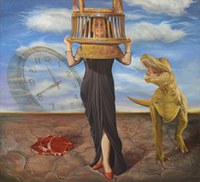Albuquerque Museum Presents "Vivarium: Exploring Intersections of Art, Storytelling, and the Resilience of the Living World"
Albuquerque Museum presents Vivarium: Exploring Intersections of Art, Storytelling, and the Resilience of the Living World, on view June 22, 2024 – February 9, 2025. The exhibition features multiple works by seven distinguished artists: Nathan Budoff; Patrick McGrath Muñíz; Steven J. Yazzie (Diné/Santa Clara Pueblo); Eliza Naranjo Morse (Santa Clara Pueblo); Stanley Natchez (Shoshone-Tataviam); Julie Buffalohead (Ponca Tribe Indians of Oklahoma); and Eloy Torrez.
The exhibition also includes a selection of works from the Tia Collection, including paintings by Nanibah Chacon, Julio Larraz, and more. By exploring the delicate balance within nature through a variety of visual languages and cultural lenses, Vivarium invites viewers into a vibrant exploration of diverse environments. Latin for "place of life," the title Vivarium encapsulates the convergence of each artist's unique perspective to form a dialogue about how the non-human living world strives to survive even when human constructs threaten its existence.
While the word “vivarium” can also be defined as enclosing, restricting, or otherwise pinning down the non-human world, this exhibition is about flipping the microscope on ourselves. It juxtaposes the natural environment with the unnatural structures, relationships, and confines that humans have built alongside the worlds of animals.
“All of the featured artists engage in a dynamic and thought-provoking visual dialog that is embedded in the practice of painting and drawing,” Curator Josie Lopez, PhD, said. “Vivarium is more than a collection of artworks; it is a journey through diverse perspectives and artistic expressions that converge to highlight the importance of environmental consciousness and cultural reflection.”
Examples of featured artists include Nathan Budoff, whose paintings place the animal world center stage as protagonists, reflecting the past and present realities of climate change and colonization in Puerto Rico. Budoff's work challenges viewers to reconsider the boundaries between built and natural environments, encouraging a deeper appreciation for the interconnectivity of all life forms.
Patrick McGrath Muñíz, whose paintings use classical, colonial, and renaissance styles, builds complex narratives to offer a critical view of contemporary culture through the lens of historical and religious imagery. His paintings, rich in symbolism, confront the viewer with the impact of consumerism and environmental neglect. McGrath Muñíz's work serves as a bridge between past and present, urging a contemplation of our collective responsibility in shaping the future.
Eliza Naranjo Morse (Santa Clara Pueblo) explores themes of growth, decay, and regeneration. Her work, deeply personal yet universally resonant, invites viewers to consider the cyclical nature of life and the resilience of the natural world. Naranjo's art, while introspective, speaks to the broader narrative of ecological balance and the human role within it as she specifically engages with her ancestral homeland in New Mexico. She builds on the cultural experiences of her elders while forging new relationships with land and the living world.
Drawing from his Diné heritage, the work of Steven J. Yazzie creates a space in his works where viewers can reflect on the significance of place and identity in the context of environmental stewardship. His art is a powerful reminder of the cultural dimensions of our relationship with the earth and animal characters that are seen as part of the human world. According to Yazzie, “For the Navajo/Diné, Coyote is a character of transgressive power, a revered cultural being whose actions are often seen as a reflection of our own human morality.”
Elloy Torrez’s paintings, like a vivarium, are often constructed worlds of their own. He blends elements of surrealism, pop culture, and personal memory to realize narrative paintings that connect universal aspects of the past and the present as well as land, people, and animals. His narrative paintings and portraits included in this exhibition delve into the complex interconnectedness of the living world and the human psyche.
Vivarium not only showcases the talents of the artists but also serves as a catalyst for dialog and action in the face of ecological and societal challenges. It is a vivid reminder of the power of art to inspire change and foster a deeper connection with the world around us.
This exhibition is curated by the Albuquerque Museum.
OPENING EVENTS:
Saturday, June 22:
1-5 p.m. - Opening Reception
2 p.m. - Opening Conversation with the artists:
Exploring Intersections of Art, Storytelling, and the Resilience of the Living World

